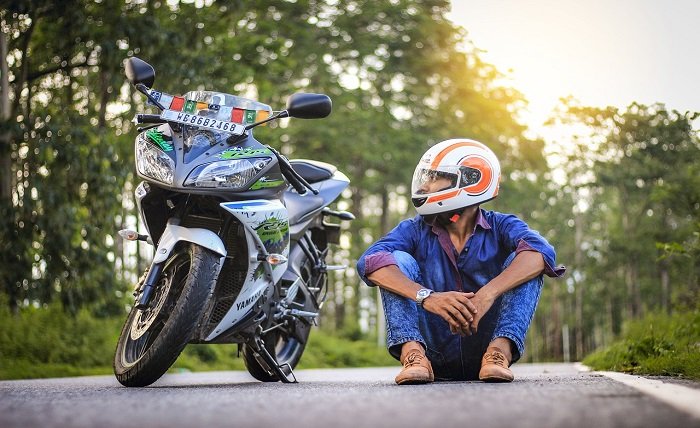The Art of Capturing a Rider Bike Photo: A Complete Guide

Rider bike photography has become a popular genre in the world of action and sports photography. Capturing the essence of a rider in motion, paired with the dynamic energy of a bike, can produce striking images that tell powerful stories. Whether you’re a professional photographer or an enthusiast, knowing how to capture a perfect rider bike photo requires both technical skill and creativity. In this blog, we will guide you through the techniques, tips, and best practices to capture breathtaking rider bike photos that stand out.
Essential Equipment for a Rider Bike Photo
To capture a perfect rider bike photo, you need the right gear. While smartphones with quality cameras are capable, professional photographers often prefer DSLR or mirrorless cameras. A camera with fast autofocus and high frame rate is crucial to catch the motion of the rider and bike. Additionally, choosing the right lens is important; wide-angle lenses are ideal for action shots as they allow you to capture both the rider and the surroundings. A tripod may also help stabilize the camera, especially when shooting in low light or slower shutter speeds.
Lighting for Rider Bike Photos
Lighting plays a vital role in capturing an exceptional rider bike photo. Natural light, especially during the golden hour (just after sunrise or before sunset), can add a warm glow to your images, highlighting both the rider and the bike. However, if you’re shooting in lower light conditions, consider using artificial lighting such as flashes or continuous lights. It’s also important to manage shadows effectively; too much contrast can obscure details of the bike and rider. Experiment with different lighting setups to create mood and emphasis on specific details like the wheels, gears, or the rider’s posture.
Choosing the Right Location for a Rider Bike Photo
Selecting the right location is critical when shooting a rider bike photo. The background and surroundings can make a significant difference in the composition of the photo. Urban settings, trails, mountains, or open roads offer different moods and textures for your shot. When choosing a location, consider the story you want your photo to tell. If you want to highlight the speed and power of the rider, an open road or a race track might be ideal. For an adventurous and rugged feel, trails or mountain biking locations can provide a natural, dynamic backdrop.
Composition Tips for a Stunning Rider Bike Photo
Composition is key in creating an eye-catching rider bike photo. One of the most common techniques is the “rule of thirds,” where the rider or bike is positioned off-center, leaving room for the background to tell a story. Additionally, you can use leading lines (such as roads or trails) to direct the viewer’s attention towards the rider. Framing the shot with elements like trees, buildings, or fences can add depth and interest. Play around with different angles, such as shooting from a low angle to emphasize the power of the bike or from above to showcase the rider’s skill and environment.
Capturing Motion in Rider Bike Photos
One of the defining features of a rider bike photo is the sense of motion. To capture this, use fast shutter speeds to freeze the action, especially when shooting high-speed movements. On the other hand, slower shutter speeds can create a sense of motion blur, giving the image a dynamic, high-energy feel. Panning is a technique where you move your camera along with the rider, resulting in a sharp rider and bike with a blurred background. This technique emphasizes speed and motion, creating a dynamic rider bike photo that is full of energy.
Focus on Rider and Bike Details
While capturing the motion of the rider and bike is important, don’t forget to focus on the details. Close-up shots of the rider’s gear, hands on the handlebars, or the tires gripping the ground can create a more intimate and striking rider bike photo. These details can help tell a more personal story of the rider’s experience. Similarly, close-up shots of the bike itself, highlighting unique components like the wheels, pedals, or gears, can add texture and depth to your photos. It’s these small details that often elevate a good photo to a great one.
The Importance of Timing in Rider Bike Photos
Timing is crucial in rider bike photography, especially when you’re trying to capture an action shot that conveys speed and intensity. The right moment can make all the difference, whether you’re waiting for the rider to jump, take a sharp turn, or reach the peak of a climb. Using continuous shooting mode on your camera can help you capture a series of frames, increasing the chances of getting the perfect shot. Be patient, as capturing the ideal moment often requires observation and quick reflexes to press the shutter at the right time.
Post-Processing for Rider Bike Photos
After you’ve captured your rider bike photo, post-processing can help bring out the best in your image. Editing software like Adobe Lightroom or Photoshop can be used to adjust exposure, contrast, and sharpness. Enhancing colors and highlights can make the image pop, while reducing noise or correcting lens distortion can improve the overall quality. However, it’s important to strike a balance—over-editing can detract from the authenticity of the moment. Focus on enhancing the image’s natural beauty while maintaining the realism of the rider and bike.
How to Share Your Rider Bike Photos
Once you’ve captured and edited your rider bike photo, it’s time to share your work with the world. Social media platforms like Instagram, Facebook, and Pinterest are ideal for showcasing action photography. When sharing, consider adding hashtags like #RiderBikePhoto or #BikePhotography to reach a broader audience. Engaging with other photographers or enthusiasts in the biking community can also help you gain visibility and feedback. Additionally, creating a portfolio website can be a great way to showcase a collection of your best rider bike photos.
Conclusion
Capturing the perfect rider bike photo is a combination of skill, patience, and creativity. Whether you’re photographing a professional cyclist or a weekend enthusiast, the right techniques, equipment, and locations can make all the difference. Remember that photography is an art form, and there are no hard and fast rules—experiment with different angles, lighting, and settings to find your unique style. By applying the tips shared in this guide, you’ll be well on your way to mastering rider bike photography and creating stunning images that capture the thrill and energy of the sport.
FAQs
What camera is best for capturing rider bike photos?
A DSLR or mirrorless camera with fast autofocus and a wide-angle lens is ideal for capturing dynamic rider bike photos.
How can I capture motion in my rider bike photos?
Use a fast shutter speed to freeze motion, or try panning with a slower shutter speed to create motion blur for a dynamic effect.
What are some good locations for rider bike photos?
Locations like open roads, mountain trails, and race tracks are excellent for capturing the action and energy of rider bike photos.
Can I use my smartphone for rider bike photography?
Yes, many smartphones have high-quality cameras that can capture great action shots with the right techniques and settings.
How can I improve the composition of my rider bike photos?
Use the rule of thirds, framing, and leading lines to create engaging compositions, and experiment with different angles for variety.




